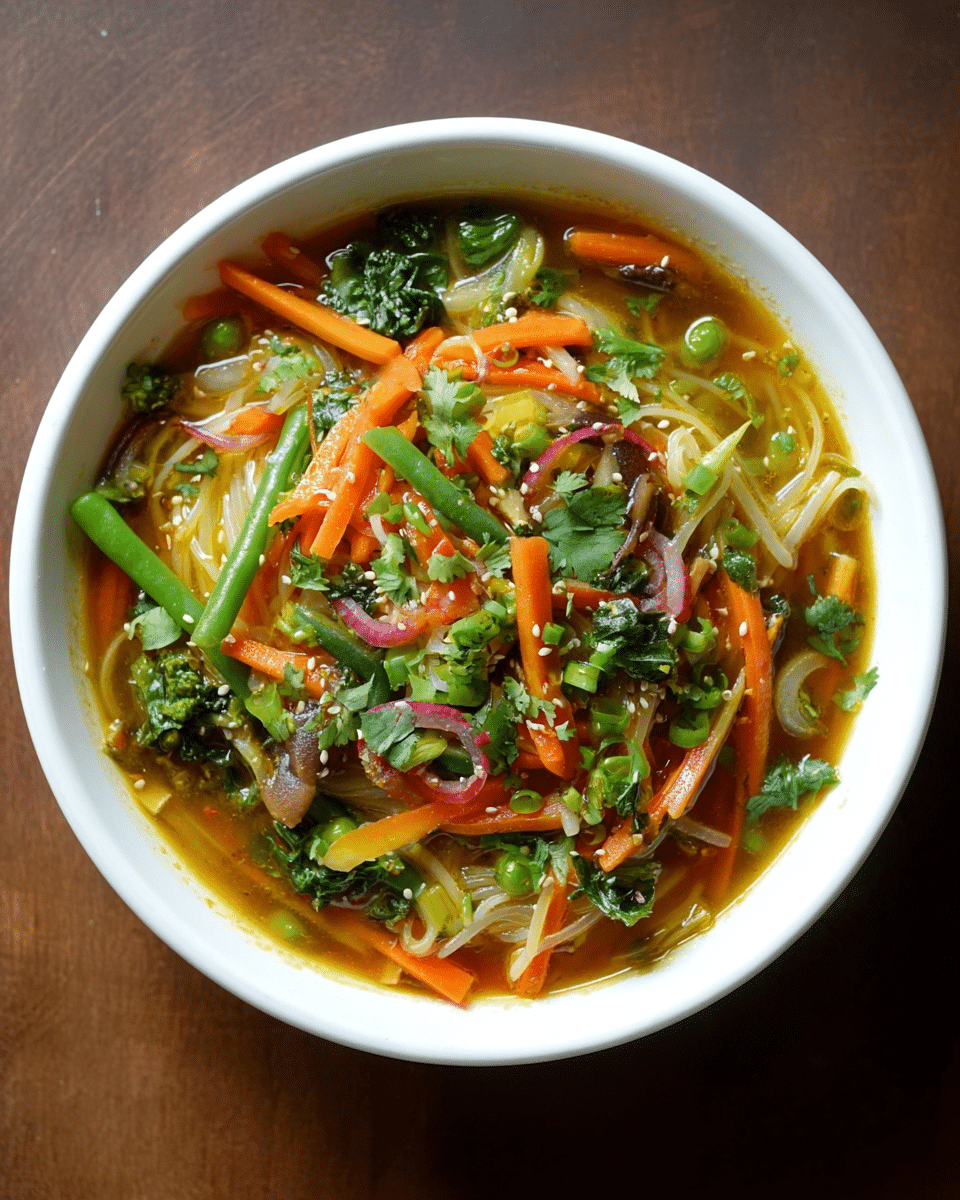This Vegetable Thukpa is a colorful and comforting soup, filled with vibrant vegetables and perfectly spiced to warm you up. The combination of tender noodles and fragrant broth makes this dish a hearty meal that satisfies both the stomach and soul.
Perfect for chilly days, this soup not only offers a variety of textures but also rich flavors from the sesame oil, soy sauce, and rice vinegar. It’s a versatile dish that can be customized to your taste by adding more vegetables or adjusting the spice level. Whether you’re craving something light or filling, this Thukpa delivers a flavorful experience every time.
Full recipe:
Ingredients:
-
1 tablespoon vegetable oil
-
1 onion, thinly sliced
-
1 teaspoon ginger, minced
-
2 cloves garlic, minced
-
1/2 cup carrots, julienned
-
1/2 cup cabbage, shredded
-
1/2 cup spinach, chopped
-
1/4 cup green beans, chopped
-
1/2 cup mushrooms, sliced
-
4 cups vegetable broth
-
1 tablespoon soy sauce
-
1 tablespoon sesame oil
-
1 tablespoon rice vinegar
-
2 teaspoons chili paste or chili flakes (optional)
-
100g noodles (your choice, rice noodles recommended)
-
Salt and pepper to taste
-
Fresh cilantro, for garnish
-
1 teaspoon sesame seeds (optional)
Directions:
-
Heat the vegetable oil in a large pot over medium heat. Add the onion and sauté for 2-3 minutes until softened.
-
Add the ginger and garlic, cooking for another minute until fragrant.
-
Add the carrots, cabbage, spinach, green beans, and mushrooms. Stir-fry for 3-4 minutes until the vegetables begin to soften.
-
Pour in the vegetable broth and bring it to a simmer. Let it cook for 5-7 minutes until the vegetables are tender.
-
Stir in the soy sauce, sesame oil, rice vinegar, and chili paste (if using). Taste and adjust seasoning with salt and pepper.
-
Add the noodles to the pot and cook for 4-5 minutes, or until the noodles are tender.
-
Once done, ladle the soup into bowls and garnish with fresh cilantro and sesame seeds if desired.
Prep Time: 10 minutes | Cooking Time: 15 minutes | Total Time: 25 minutes | Kcal: 220 kcal | Servings: 4 servings
A Brief History of Thukpa
Thukpa traces its roots to Tibet and has been a staple in Himalayan cuisine for centuries. The dish originally emerged as a simple, nourishing meal for the Tibetan people, perfect for cold climates and long winters. Over time, Thukpa made its way into Nepal, Bhutan, and northern India, where regional variations have taken shape. In Nepal, Thukpa has become a beloved street food, especially in the winter months, thanks to its warming and comforting qualities. Though Thukpa was originally a meat-based dish, vegetarian versions have gained popularity due to their healthy, light, and plant-based ingredients.
A Perfect Combination of Spices and Vegetables
The beauty of Vegetable Thukpa lies in its balance of flavors. The base of the soup is typically made with vegetable broth, infused with aromatic spices, ginger, garlic, soy sauce, and sometimes chili paste. The spicy yet earthy broth blends beautifully with the fresh vegetables, offering a wholesome and nourishing dish. The soup is typically loaded with vegetables like carrots, cabbage, spinach, and green beans, but you can customize it based on what you have in your kitchen. The combination of crunchy and tender vegetables adds various textures, making every spoonful exciting and fulfilling.
The Health Benefits of Vegetable Thukpa
Vegetable Thukpa isn’t just delicious – it’s also a nutritious meal. The dish is packed with vitamins, minerals, and antioxidants from the vegetables, such as carrots, spinach, and mushrooms, that help support immune function and boost overall health. The soup’s base of vegetable broth provides hydration while remaining light, making it an excellent choice for those looking for a low-calorie yet filling meal.
The noodles in Thukpa serve as a good source of carbohydrates, giving you the energy you need to power through your day. If you’re looking for a gluten-free or grain-free option, you can easily substitute traditional noodles with rice noodles or zucchini noodles. The use of sesame oil and soy sauce adds depth to the flavor and provides healthy fats, promoting heart health.
In addition, the spices like ginger, garlic, and chili have their own health benefits. Ginger is known for its anti-inflammatory properties and helps with digestion, while garlic is excellent for boosting immunity. The chili paste or flakes, depending on how much you use, add a spicy kick to the soup and can help stimulate your metabolism.
Vegetable Thukpa as a Versatile Meal
One of the reasons why Vegetable Thukpa is so popular is its versatility. You can easily adjust the ingredients to suit your taste or dietary preferences. For example, you can add tofu or tempeh for added protein, or even top the soup with a soft-boiled egg for extra richness. Vegetables like broccoli, bell peppers, and zucchini can also be added to the mix, giving the dish more variety and nutrition.
If you prefer a milder flavor, you can reduce the amount of chili paste or opt for a milder type of chili. For a heartier meal, consider adding more noodles, which will absorb the flavorful broth and provide a comforting, satisfying texture. Additionally, the recipe can be made vegan or vegetarian, depending on the stock and ingredients you use, making it an excellent choice for anyone following plant-based diets.
How to Make Vegetable Thukpa a Family Favorite
Making Vegetable Thukpa is simple, but with a few tweaks, you can elevate it into a dish that will be loved by everyone in the family. The key to a great Thukpa is in the broth – ensuring it’s flavorful and well-seasoned will create the base for a delicious dish.
If you’re cooking for kids or people who aren’t fond of spicy food, adjust the heat level by reducing the chili paste or leaving it out altogether. You can also swap the soy sauce with tamari if you’re concerned about gluten. To make the meal more filling, consider serving it with a side of garlic bread or dumplings, which can be dipped into the flavorful broth.
For a more festive touch, add garnishes like freshly chopped cilantro, lime wedges, and sesame seeds before serving. These garnishes not only add a burst of color but also enhance the flavor with a refreshing zest.
The Versatility of Noodles in Thukpa
Thukpa is traditionally made with wheat noodles, but the dish is extremely versatile in terms of the type of noodles you can use. While rice noodles are often the choice for a gluten-free version, you can also use whole-wheat noodles for a healthier alternative.
If you prefer a more substantial option, try using soba noodles, which are made from buckwheat and have a slightly nutty flavor. Egg noodles, a popular choice in many Asian dishes, can also be used for added richness. If you’re looking to reduce carbs, you can even substitute noodles with zucchini noodles or other vegetable-based alternatives for a lighter dish.
The key is to ensure that the noodles are cooked to perfection, as they’ll absorb the soup’s broth and enhance the overall experience. Be sure to add the noodles last to avoid overcooking them.
How to Customize Your Thukpa for Different Seasons
Though Vegetable Thukpa is often associated with cold weather, its adaptability makes it a year-round dish. In the winter, it’s a warming, nourishing meal that fills you with comfort and satisfaction. The rich broth and hearty vegetables are the perfect antidote to the chill.
In the spring and summer months, consider using lighter vegetables, such as peas, asparagus, and baby spinach, to keep the dish fresh and vibrant. You can even serve it chilled for a refreshing twist on the traditional warm version. Adding fresh herbs like basil, mint, or cilantro can add brightness to the dish, giving it a seasonal flair.
Vegetable Thukpa for Meal Prep
Thukpa is an excellent choice for meal prepping. The soup stores well in the fridge for up to three days and can be easily reheated for a quick meal throughout the week. If you’re making a big batch, consider storing the noodles and broth separately to prevent the noodles from absorbing too much liquid. When you’re ready to eat, simply reheat the soup and add the noodles.
The broth also freezes well, making it convenient for preparing ahead of time. Store the broth in airtight containers, and when you’re ready for a quick meal, just add your choice of vegetables and noodles, and you have a healthy and flavorful dish in no time.
Conclusion: Why You Should Try Vegetable Thukpa
Vegetable Thukpa is more than just a soup; it’s a wholesome, flavorful meal that is perfect for any occasion. Whether you’re craving something light and healthy or looking for a filling, satisfying dish, Thukpa offers the best of both worlds. Its rich, flavorful broth, combined with a medley of fresh vegetables and noodles, makes for a truly comforting and versatile meal. Plus, with its wide range of variations and adaptations, it’s a dish that can be customized to suit anyone’s dietary preferences or taste.
The best part? It’s incredibly easy to make and is an excellent choice for meal prepping. Whether you’re serving it to friends and family or enjoying a bowl on your own, Vegetable Thukpa is sure to become a go-to dish in your culinary repertoire.
So, next time you’re looking for a healthy, delicious, and comforting meal, give Vegetable Thukpa a try – you won’t regret it!






